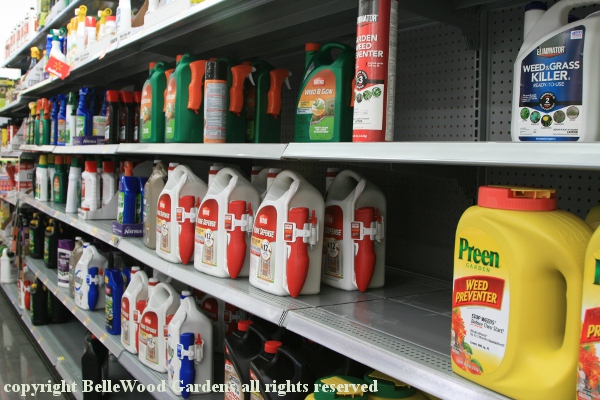
.
If you have any comments, observations, or questions about what you read here, remember you can always Contact Me
All content included on this site such as text, graphics and images is protected by U.S and international copyright law.
The compilation of all content on this site is the exclusive property of the site copyright holder.
What is a weed? At its most basic, a weed is a plant growing where it is not wanted.

Garden centers and big box stores have a wide array of herbicides, plant poisons.
But do people who purchase them understand when and how to choose and use?
Remember that a herbicide kills plants, it does not evaporate them. They die, dry
and - especially large and / or woody plants - will have ugly remains to haunt you.
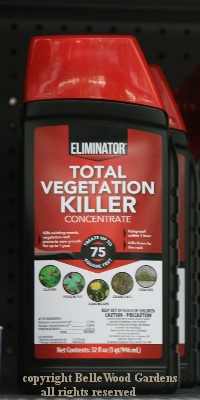
Here is one, appropriately named, that promises to kill all plants.
I'm a gardener. I do not want to kill all plants, create a barren waste.
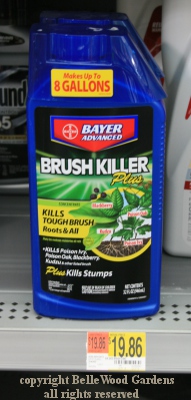
Another problem. Large containers that make far more herbicide than I want or need. Eight gallons of brush killer? There were no smaller containers in the store. Even eight ounces of concentrate would last me for years. I'm only using tiny amounts for targeted applications. For example - when trying to remove multiflora rose too established to dig out I cut canes back to a short stub, then promptly use a disposable foam brush to wipe the cut ends with brush killer. That protects adjacent plants from accidental overspray.
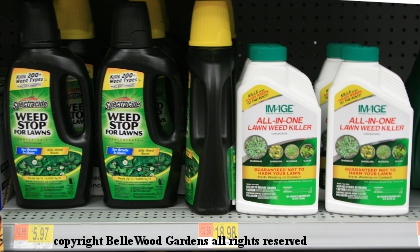
Some people want a perfect lawn, green grass like a velvet carpet. Weeds are an anathema to them. No violets or clover, dandelions or plantain. How does a herbicide distinguish between grass and not-grass? It's like this. Grass in a monocot. It germinates with a single seed leaf, and grass leaves have parallel venation. (Other monocots include important food crops such as corn and wheat, ornamental plants like iris, familiar bulbs such as daffodils, lilies, and gladiolus.) Dicots are plants that germinate with two seed leaves, have more complex leaves, and net-like venation. They include tomatoes, marigolds, dahlias, and also clover, violets, dandelions. and plantain. So weed killers specifically for lawns target dicot plants.
How about instead of aiming for a perfect grass-only lawn consider instead a medieval greensward, a charming tapestry mixed planting of grass, clover, violets, low growing herbs such as creeping thyme, creeping chamomile, Anthemis nobilis, creeping phlox, Phlox subulata. But I digress.
We've decided that a weed is an unwanted plant, a plant - perhaps wanted in one place - that is growing in a place where we do not want it to grow. Sometimes the place is what makes it a problem. Plants growing between paving stones, in the spaces between pavers on a patio, in a gravel pathway,
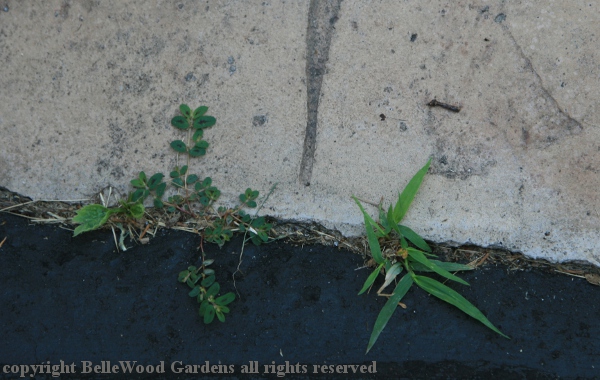
or growing in that paper-thin crevice between the driveway and front walk.
Crab grass, black medic, don't know, and dry grass bits from mowing lawn.
Cannot hand pull - the weeds break and regrow from the roots. No tool fits
into the crevice - trowel etc too thick for the space. What to do, what to do.
When all else fails, look on-line. Which is where I found
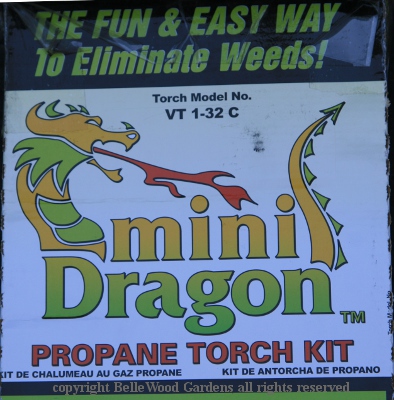
a mini-dragon flame torch! It overheats the leaves and plant dies.
How cool is that! A Kansas company named Flame Engineering
makes a wide array of torch kits, everything from the mini-dragon
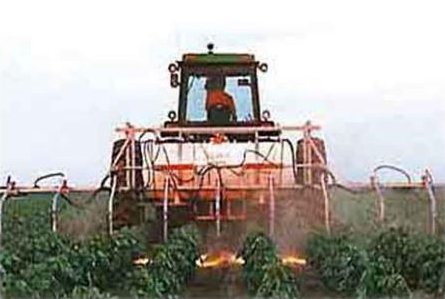
image by digital commons University of Nebraska, Lincoln
up to huge multi-nozzle pull behind a tractor in a corn field size unit.
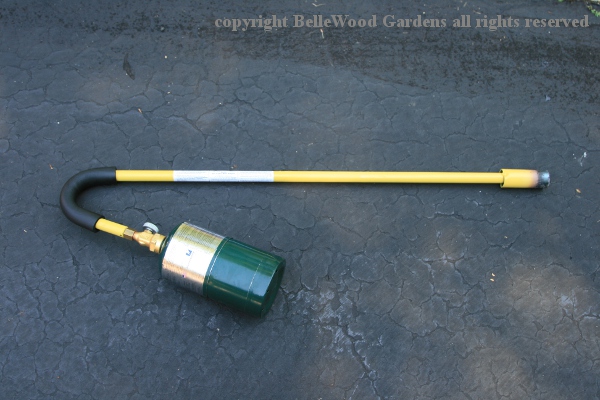
The mini-dragon comes with angled yellow pipe torch that has a non-slip grip.
A spark lighter also included. You provide a propane cylinder, 14 ounce or larger.
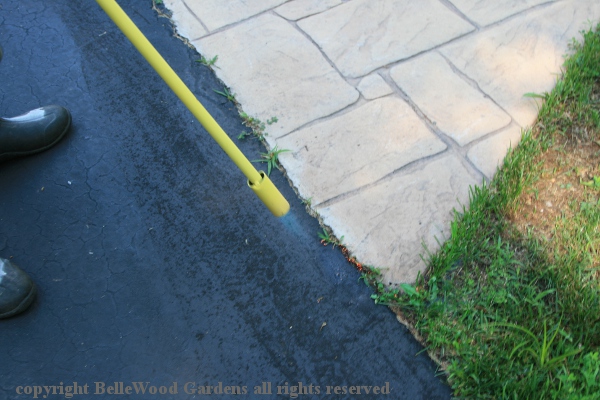
Ready, set, flame! Remember - the idea is to overheat the weeds, not incinerate them. There is a flame adjusting knurled knob just above the propane cylinder. I felt it was safe to try out the mini-dragon with just the few scraps of dry grass near the walk and driveway but in a different situation it would be prudent to clear away dry leaves, pine needles, and other burnable material. It would be sensible to have a hose hooked up, or a fire extinguisher handy when a larger area is going to be treated around the house. Other very sensible precautions - don't use a dragon flame torch to weed poison ivy - can be found in the flame weeding 101 guidelines that the company has on-line.
Another use for a weed torch comes to mind. Back in March of 2015 I visited a friend
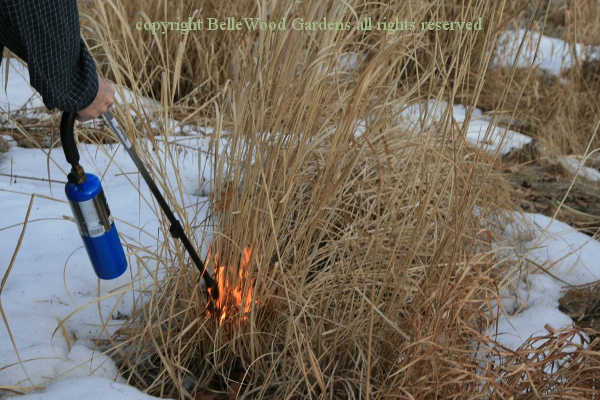
when he was torching the tall winter-dead growth of ornamental grasses. There is snow on the ground, the grasses are more like tinder than fuel. And in seconds each was reduced to black ash, clearing the way for new growth in spring just like the great grassland prairies of the Midwest which are a fire ecology landscape.
I like my mini-dragon weed torch. Clearly, it will be especially useful in eliminating smaller weeds in difficult to manage sites such as stony crevices between paving stones along walkways, driveways, sidewalks or in gravel areas. I do need to familiarize myself with it by more frequent use - in bright sunlight it can be difficult to see the flame. Also, I find I prefer the Aim 'n Flame extra long utility butane lighter that we use for the gas fireplace to the spark igniter.
Another good thing - my mini-dragon flame weeder is considered an organic method for controlling weeds. Fewer obnoxious chemicals to store in the garage year after year after decade. It is really a delightful technique for dealing with weeds. And a mini-dragon is user friendly, unlike Daenerys's three in Game of Thrones.
A sample mini-dragon propane torch kit was provided by Flame Engineering.
Back to Top
Back to July 2018
Back to the main Diary Page